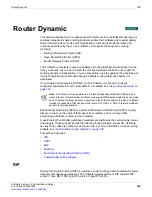
Router Static
Static Route
FortiGate Version 4.0 Administration Guide
01-400-89802-20090424
283
•
Figure 165: Destinations on networks behind internal routers
To route packets from Network_1 to Network_2, Router_1 must be configured to use the
FortiGate internal interface as its default gateway. On the FortiGate unit, you would create
a new static route with these settings:
Destination IP/mask: 192.168.30.0/24
Gateway: 192.168.11.1
Device: dmz
Distance: 10
To route packets from Network_2 to Network_1, Router_2 must be configured to use the
FortiGate dmz interface as its default gateway. On the FortiGate unit, you would create a
new static route with these settings:
Destination IP/mask: 192.168.20.0/24
Gateway: 192.168.10.1
Device: internal
Distance: 10
Changing the gateway for the default route
The default gateway determines where packets matching the default route will be
forwarded.
To change the gateway for the default route
1
Go to
Router > Static > Static Route
.
Network_2
192.168.30.0/24
FortiGate_1
internal
dmz
Gateway
Router_1
192.168.10.1
Gateway
Router_2
192.168.11.1
Internet
Network_1
192.168.20.0/24
Note:
If you are using DHCP or PPPoE FortiGate over a modem interface on your
FortiGate unit, you may have problems configuring a static route. After trying to either
Renew your DHCP license, or Reconnect the PPPoE connection, go to the CLI and enable
dynamic-gateway
under
config system interface
for the modem interface. Doing
this will remove the need to specify a gateway for this interface’s route. For more
information see
.
Summary of Contents for Gate 60D
Page 705: ...www fortinet com...
Page 706: ...www fortinet com...






























